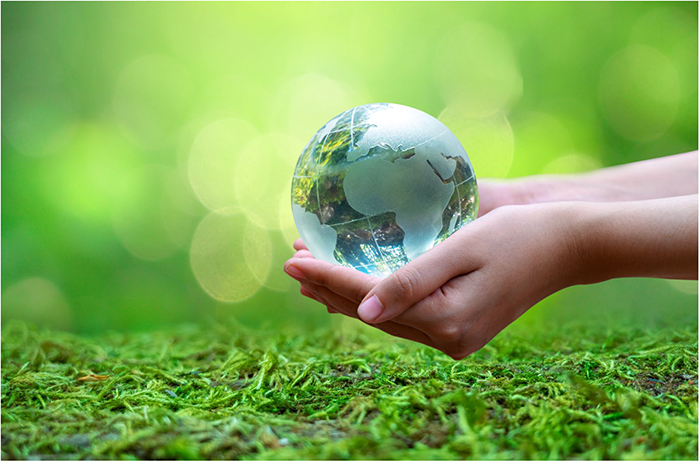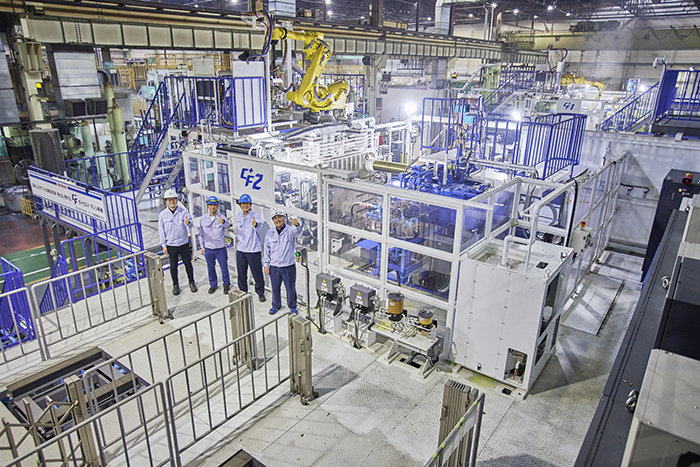Newsletter : Production Site Initiatives to Create a Decarbonized Society -- Expediting Our Factory Carbon-Neutrality Goal to 2035 --
September 26, 2022

Yamaha Motor announced that the target date for achieving carbon neutrality at its domestic and international factories--a goal in the Yamaha Motor Group Environmental Plan 2050 revised in July 2021--has been accelerated to 2035.
To achieve this new goal, we will push initiatives centered on minimizing energy use as well as relying on cleaner energy. The projected result of these moves by 2035 is a 92% reduction in CO2 emissions (compared to 2010) from production operations at domestic and international factories.
Furthermore, remaining CO2 emissions will be offset by internationally recognized methods to carry out the plan to achieve carbon neutrality at all our factories.
■Minimization and Clean Energy to Take CO2 Emissions to Zero
Carbon Neutrality Plan for Yamaha Motor Plants

We are aiming to make all our factories carbon-neutral by 2035
by focusing on minimization and relying on clean energy.
by focusing on minimization and relying on clean energy.
In May 2019, Yamaha Motor endorsed the recommendations of the Task Force on Climate-related Financial Disclosures (TCFD) and has worked to identify and manage the opportunities and risks posed by climate change that may affect our business, incorporating adaptive and mitigative climate change measures into our business strategies accordingly.
On the other hand, the effects of global warming are becoming more and more pronounced, and countries around the world are stepping up efforts to tighten environmental regulations and promote decarbonization. Against this backdrop, we conducted a review of the Yamaha Motor Group Environmental Plan 2050 and announced the revisions made in 2021, which included moving up the target period by 15 years for achieving carbon neutrality at our plants worldwide. The facilities this move targets include Yamaha Motor's domestic factories, those at 131 overseas group companies, as well as three Chinese joint-ventures producing complete Yamaha vehicles.
Yamaha has already achieved a 46% reduction in CO2 emissions at our production sites compared to 2010 thanks to our initiatives to date. In addition, we plan to bring our carbon-based electricity consumption to zero by 2030 on a global scale by accelerating innovation in our manufacturing and production processes. At the same time, we will drive initiatives to minimize energy consumption as well as rely on clean electricity by switching to carbon-free sources such as solar, wind, and hydroelectric power generation. We will also move to reduce CO2 emissions produced from equipment using fossil fuels by gradually shifting to versions employing alternative energy sources, such as electricity and hydrogen.
On the other hand, the effects of global warming are becoming more and more pronounced, and countries around the world are stepping up efforts to tighten environmental regulations and promote decarbonization. Against this backdrop, we conducted a review of the Yamaha Motor Group Environmental Plan 2050 and announced the revisions made in 2021, which included moving up the target period by 15 years for achieving carbon neutrality at our plants worldwide. The facilities this move targets include Yamaha Motor's domestic factories, those at 131 overseas group companies, as well as three Chinese joint-ventures producing complete Yamaha vehicles.
Yamaha has already achieved a 46% reduction in CO2 emissions at our production sites compared to 2010 thanks to our initiatives to date. In addition, we plan to bring our carbon-based electricity consumption to zero by 2030 on a global scale by accelerating innovation in our manufacturing and production processes. At the same time, we will drive initiatives to minimize energy consumption as well as rely on clean electricity by switching to carbon-free sources such as solar, wind, and hydroelectric power generation. We will also move to reduce CO2 emissions produced from equipment using fossil fuels by gradually shifting to versions employing alternative energy sources, such as electricity and hydrogen.
■Applying Yamaha Motor's Unique Theoretical Value Approach
"Theoretical-value-based energy" to isolate the true value in energy

The energy consumed in manufacturing and production operations
is broken down into types defined as "value," "semi-value," or "non-value."
In devising initiatives to achieve carbon neutrality, Yamaha Motor has adapted the theoretical-value-based approach rooted in its manufacturing and production operations to create a unique "theoretical-value-based energy" approach. This method seeks to achieve breakthroughs by classifying all consumed energy into energy with value, semi-value, or non-value, and strives to increase the degree of "value" as much as possible. For example, any standby time between work processes is considered non-value, so efforts are underway to automatically shut down equipment by modifying their control programs in order to reduce the energy consumed during that time to zero.
Such theoretical-value-based thinking is widespread at Yamaha, not only in our manufacturing and production arms but also in procurement, logistics, and more. Since energy is particularly easy to visualize in terms of data, the theoretical ideal values are easier to determine, and in terms of minimization, we are already seeing significant results. These include achieving the targets set in the Japanese government's Act on the Rational Use of Energy (Energy Conservation Act) some three times faster than stipulated.
On the other hand, Yamaha's efforts to reduce CO2 emissions from fossil fuel sources are also being made at a rapid pace through reforms to facility equipment and processes. One example of this is the introduction of a new die-casting machine at a casting factory, which successfully reduced CO2 emissions produced in motorcycle frame manufacturing by 49% compared to the previous machinery. The introduction of new technologies and equipment for the painting line to drastically reduce emissions there is also under consideration as it too is a high-temperature process.
As the manufacturing sites around the world responsible for creating Yamaha Motor products share their individual issues and new solutions, the company as a whole is taking on the massive challenge of achieving carbon neutrality as a global team and making steady progress toward its new goal of carbon-free manufacturing by 2035.
Such theoretical-value-based thinking is widespread at Yamaha, not only in our manufacturing and production arms but also in procurement, logistics, and more. Since energy is particularly easy to visualize in terms of data, the theoretical ideal values are easier to determine, and in terms of minimization, we are already seeing significant results. These include achieving the targets set in the Japanese government's Act on the Rational Use of Energy (Energy Conservation Act) some three times faster than stipulated.
On the other hand, Yamaha's efforts to reduce CO2 emissions from fossil fuel sources are also being made at a rapid pace through reforms to facility equipment and processes. One example of this is the introduction of a new die-casting machine at a casting factory, which successfully reduced CO2 emissions produced in motorcycle frame manufacturing by 49% compared to the previous machinery. The introduction of new technologies and equipment for the painting line to drastically reduce emissions there is also under consideration as it too is a high-temperature process.
As the manufacturing sites around the world responsible for creating Yamaha Motor products share their individual issues and new solutions, the company as a whole is taking on the massive challenge of achieving carbon neutrality as a global team and making steady progress toward its new goal of carbon-free manufacturing by 2035.

High-temperature processes like casting and painting present significant hurdles in achieving fossil-free production. The new die-casting machines installed at the Iwata Main Factory cut CO2 emissions by 49% compared to the previous machines.
Yamaha Motor Expediting Carbon Neutrality Goal for Company Factories to 2035 News release issued June 28, 2022
Message from the Editor
Sustainability is one of the pillars in Yamaha Motor's new Medium-Term Management Plan (2022-2024). As a company actively working to create a more sustainable world, we have ramped up our efforts toward carbon neutrality and I hope you look forward to seeing how we will tackle reducing CO2 emissions at our manufacturing and production sites worldwide.
■Contact us from the Press
Corporate Communication Division, PR group: +81-3-5220-7211
■News Center: https://global.yamaha-motor.com/news/
Corporate Communication Division, PR group: +81-3-5220-7211
■News Center: https://global.yamaha-motor.com/news/
